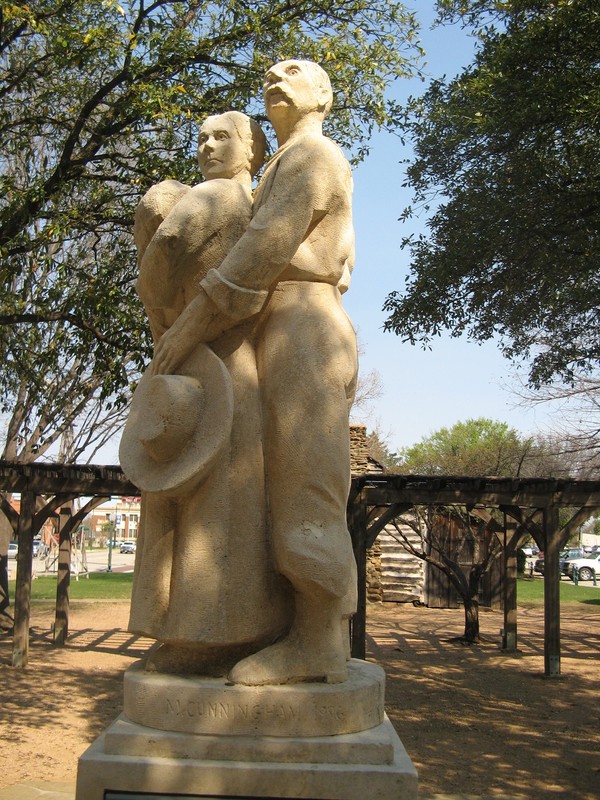Walking to Texas fountain
Introduction
Text-to-speech Audio
Limestone statue honoring early settlers of Grapevine, Texas. Stands in the middle of a horse head fountain honoring Native Americans of the region. Installed as part of revitalization of Grapevine's historic downtown.
Images
Walking to Texas statue

Walking to Texas statue and fountain

Backstory and Context
Text-to-speech Audio
In 1996, Grapevine, Texas, erected a pioneer family monument as the first of several public statues in its historic downtown area. First settled by whites in the mid-nineteenth century, Grapevine remained a small agricultural town outside Dallas and Fort Worth until after World War II. The nearby construction of Dallas-Fort Worth International Airport transformed it into a bedroom community and tourist destination. Tax revenue from DFW helped fund the revitalization of the town’s historic downtown. According to travel writer Syd Kearney, “Residents in this little, tax-rich city make up the hometown image and ambience as they go along. … In Grapevine, if it cannot be restored, it is replicated.”[1]
Local artist Mike Cunningham’s 1996 limestone sculpture of a pioneer man, woman, and infant is a centerpiece of Grapevine’s new historic district. Although Cunningham is primarily an abstract sculptor, his piece for Grapevine imitates the 1920s and 1930s Pioneer Mother Movement--except that, despite being called Walking to Texas, the characters in it stand still rather than striding purposely westward as does Ponca City's Pioneer Woman. Cunningham placed horse head fountains on the square base “represent[ing] the Four Directions and the spirit of the American Indians.”
Inscription:
Statue:
This statue honors the early settlers who walked along side their wagons to Texas seeking the promise of a better life for themselves and their children. They established the first permanent settlement of Grapevine in 1884.
William D. Tate, Orator
December 2, 1996
Michael Cunningham, Sculptor
Jerald Austin, Mason
MESA Design Group, Architect
Fountain:
Grapevine Springs
In August of 1843 General Sam Houston camped not far from here at Grapevine Springs to forge a Treaty of Peace and Friendship with the Indian Nations. This treaty would soon open North Texas to settlement. All the leaders of the Indian nation did not arrive until September 29, 1843 by which time Houston had left. The Treaty was later signed at Bird's Fort on September 29, 1843. The Indian nations were the Biloxi, Caddo, Cherokee, Chickasaw, Delaware, Ez-e-nye, Keechye, 'Nardarka, Tahwahkarro, and Waco.
Sources
[1] Syd Kearney. “Grapevine by Design." Houston Chronicle September 7, 1997. 2 Star Zone edition, sec. Texas Magazine.
"Walking to Texas" statue, The Historical Marker Database. May 1st, 2024. Accessed June 27th, 2024. https://www.hmdb.org/m.asp?m=193580.
Photo by Anna Prescott
Photo by Anna Prescott
